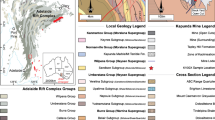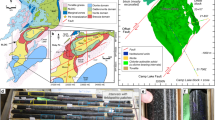Abstract
The relationships between the δ18O of quartz veins and veinlets pertaining to the main stage of gold mineralization at the Sukhoi Log deposit and metasomatically altered host slates are estimated. The oxygen isotopic composition of veined quartz and host slates is not uniform. The δ18O of quartz veins from the Western, Central, and Sukhoi Log areas of the deposit vary from +16 to + 18 ‰. The δ18O range of metasomatically altered slates in the Western and Sukhoi Log areas attains 6 ‰. The δ18O of quartz veins are always higher than those of host slates by 3–7‰. The regular difference in the δ18O between quartz veins and host slates indicates that the oxygen isotopic composition of the ore-bearing fluid forming the system of quartz veins and veinlets at the Sukhoi Log deposit could have formed as a result of interaction with silicate rocks, for instance, terrigenous slates enriched in δ18O. Such interaction, however, took place at deeper levels of the Sukhoi Log deposit. It is suggested that the fluid phase participating in the formation of the vein and veinlet system had initially high δ18O(>+10‰) due to interaction with the rocks enriched in δ18O at a low fluid/rock ratio. The oxygen isotope data indicate that the fluid participating in the formation of gold mineralization at the Sukhoi Log deposit was not in equilibrium with igneous rocks at high temperatures.
Similar content being viewed by others
References
N. S. Bortnikov, G. N. Gamyanin, O. V. Vikent’eva, V. Yu. Prokof’ev, V. A. Alpatov, and A. G. Bakharev, “Fluid Composition and Origin in the Hydrothermal System of the Nezhdaninsky Gold Deposit, Sakha (Yakutia), Russia,” Geol. Rudn. Mestorozhd. 49(2), 99–145 (2007) [Geol. Ore Deposits 49 (2), 87–128 (2007)].
N. S. Bortnikov, V. Yu. Prokof’ev, and K. V. Razdolina, “Genesis of the Charmitan Gold-Quartz Deposit, Uzbekistan,” Geol. Rudn. Mestorozhd. 38(3), 238–257 (1996) [Geol. Ore Deposits 38 (3), 208–226 (1996)].
N. S. Bortnikov, I. A. Bryzgalov, K. N. Krivitskaya, V. Yu. Prokof’ev, and O. V. Vikentieva, “The Maiskoe Multistage Stringer-Disseminated Gold-Sulfide Deposit, Chukotka, Russia: Mineralogy, Fluid Inclusions, Stable Isotopes (O, S), History, and Formation Conditions,” Geol. Rudn. Mestorozhd. 46(6), 475–509 (2004) [Geol. Ore Deposits 46 (6), 409–440 (2004)].
N. S. Bortnikov, G. N. Gamyanin, V. V. Alpatov,, V.B. Naumov, L. P. Nosik, and O. F. Mironova, “Mineralogy, Geochemistry and Origin of the Nezhdaninsky Gold Deposit (Sakha-Yakutia, Russia),” Geol. Rudn. Mestorozhd. 40(2), 137–156 (1998) [Geol. Ore Deposits 40 (2), 121–138 (1998)].
V. A. Buryak, Metamorphism and Ore Formation (Nedra, Moscow, 1982) [in Russian].
V. A. Buryak, I. S. Nemenman, K. V. Berdnikov, et al., “Fluid Regime and Source of Ore-Forming Solutions of Gold-Quartz Veins of the Allakh-Yun Zone,” Tikhookean. Geol. 9(3), 62–70 (1990).
Zh. Chang, R. R. Large, and V. Maslennikov, “Sulfur Isotope in Sediment-Hosted Orogenic Gold Deposits: Evidence for an Early Timing and a Seawater Sulfur Source,” Geology 36(12), 971–974 (2008).
R. N. Clayton, J. R. O’Neil, and T. K. Mayeda, “Oxygen Isotope Exchange between Quartz and Water,” J. Geophys. Res. 77, 3057–3067 (1972).
V. V. Distler, G. L. Mitrofanov, V. K. Nemerov, V. A. Kovalenker, A. V. Mokhov, L. K. Semeikina, and M. A. Yudovskaya, “Mode of Occurrence of the Platinum Group Elements and Their Origin in the Sukhoi Log Gold Deposit, Russia,” Geol. Rudn. Mestorozhd. 38(6), 467–484 (1996) [Geol. Ore Deposits 38 (6), 413–428 (1996)].
V. V. Distler, M. A. Yudovskaya, G. L. Mitrofanov, et al., “Geology, Composition, and Genesis of the Sukhoi Log Noble Metals Deposits, Russia,” Ore Geol. Rev. 24, 7–44 (2004).
A. M. Gavrilov and S. G. Kryazhev, “Mineralogical and Geochemical Features of Ores at the Sukhoi Log Deposit,” Razved. Okhr. Nedr, No. 8, 3–16 (2008).
L. Grancea, L. Bailly, J. Leroy, et al., “Fluid Evolution in the Baia Mare Epithermal Gold/Polymetallic District, Inner Carpathians, Romania,” Miner. Deposita 37, 630–647 (2002).
Y. Jia and R. Kerrich, “Giant Quartz Vein Systems in Accretionary Orogenic Belts: The Evidence for a Metamorphic Fluid Origin from 15N and 13C Studies,” Earth Planet. Sci. Lett. 184, 211–224 (2000).
M. Jingwen, Zh. Zuoheng, Y. Jianmin, and Zh. Zhang, “The Hanshan Gold Deposit in the Caledonian North Qilian Orogenic Belt, NW China,” Miner. Deposita 35, 63–71 (2000).
I. A. Karpenko, I. F. Migachev, B. K. Mikhailov, and N. G. Petrash, “Current Geological and Economic Assessment of the Sukhoi Log Deposit,” Rudy Met., No. 2, 22–27 (2006).
R. Kerrich and B. J. Fryer, “Lithophile-Element Systematics of Archean Greenstone Belt Au-Ag Vein Deposits: Implications for Source Processes,” Can. J. Earth Sci. 25, 945–953 (1988).
I. V. Konovalov, “Temperature Zoning and Formation Condition of the Gold Mineral Assemblages,” in Metamorphic Ore Formation (Nauka, Moscow, 1977) [in Russian].
N. P. Laverov, E. N. Lishnevsky, V. V. Distler, and A. A. Chernov, “Model of the Ore-Magmatic System of the Sukhoi Log Gold-Platinum Deposit, Eastern Siberia, Russia,” Dokl. Akad. Nauk 375(5), 652–656 (2000a) [Dokl. Earth Sci. 375A (9), 1362–1365 (2000a)].
N. P. Laverov, I. V. Chernyshev, A. V. Chugaev, E. D. Bairova, Yu. V. Golzman, V. V. Distler, and M. A. Yudovskaya, “Formation Stages of the Large-Scale Noble Metal Mineralization in the Sukhoi Log Deposit, East Siberia: Results of Isotopic Geochronological Study,” Dokl. Akad. Nauk 415(2), 1–6 (2007) [Dokl. Earth Sci. 415 (5), 810–814 (2007)].
N. P. Laverov, V. V. Distler, G. L. Mitrofanov, V. K. Nemerov, V. A. Kovalenker, A. V. Mokhov, L. K. Semeikina, and M. A. Yudovskaya, “Platinum and Other Native Metals in Ores of the Sukhoi Log Gold Deposit,” Dokl. Akad. Nauk 355(5), 664–668 (1997) [Dokl. Earth Sci. 355A (6), 904–907 (1997)].
N. P. Laverov, V. Yu. Prokof’ev, V. V. Distler, M. A. Yudovskaya, E. M. Spiridonov, V. I. Grebenshchikova, and N. L. Matel, “New Data on Ore Deposition Conditions and Composition of Ore-Forming Fluids in the Sukhoi Log Gold-Platinum Deposit,” Dokl. Akad. Nauk 371(1), 88–92 (2000b) [Dokl. Earth Sci. 3371) (2), 357–361 (1997)].
C. Lerouge, J. P. Milesi, and A. M. Fouillac, “The Paleoproterozoic Dorlin Gold Deposit, French Guiana: Genetic Constraints of the Stable Isotope Geochemistry,” Chem. Geol. 155, 131–149 (1999).
J. Lu, P. K. Seccombe, and C. S. Eldridge, “SHRIMP S-Isotope Evidence for Fluid Mixing during Gold Mineralization in a Slate-Belt Gold Deposit (Hill End, NSW, Australia),” Chem. Geol. 127, 229–240 (1996).
R. Mathur, J. Ruiz, S. Titley, et al., “Different Crystal Sources for Au-Rich and Au-Poor Ores of the Grasberg Cu-Au Porphyry Deposit,” Earth Planet. Sci. Lett. 183, 7–14 (2000).
Y. Matsuhisa, J. R. Goldsmith, and R. N. Clayton, “Oxygen Isotopic Fractionation in the System Quartz-Albite-Anorthite-Water,” Geochim. Cosmochim. Acta 43, 1131–1140 (1979).
S. Meffre, R. R. Large, R. Scott, et al., “Age and Pyrite Pb-Isotopic Composition of the Giant Sukhoi Log Sediment-Hosted Gold Deposit, Russia,” Geochim. Cosmochim. Acta (2008), doi: 10/1016/j.gca.2008/03/005.
B. E. Nesbitt and K. Muchlenbachs, “Geology, Geochemistry and Genesis of Mesothermal Lode Gold Deposits of the Canadian Cordillera: Evidence for Ore Formation from Evolved Meteoric Water,” Econ. Geol. Monograph 6, 553–563 (1989).
P. Neumayr, J. R. Ridley, N. J. McNaughton, et al., “Timing of Gold Mineralization in the Mt. York District, Pilgangoora Greenstone Belt, and Implications for the Tectonic and Metamorphic Evolution of an Area Linking the Western and Eastern Pilbara Craton,” Prec. Res. 88, 249–265 (1998).
T. Oberthur, G. Blenkinsop, U. F. Hein, et al., “Gold Mineralization in the Mazowe Area, Harare-Bindura-Shamva Greenstone Belt, Zimbabwe: II. Genetic Relationships Deduced from Mineralogical, Fluid Inclusion and Stable Isotope Studies, and the Sm-Nd Isotopic Composition of Scheelites,” Miner. Deposita 35, 138–156 (2000).
C. S. Rombach and R. J. Newberry, “Shotgun Deposit: Granite Porphyry-Hosted Gold-Arsenic Mineralization in Southwestern Alaska, USA,” Miner. Deposita 36, 607–621 (2001).
V. L. Rusinov, O. V. Rusinova, S. G. Kryazhev, Yu. V. Shchegol’kov, E. I. Alysheva, and S. E. Borisovsky, “Wall-Rock Metasomatism of Carbonaceous Terrigenous Rocks in the Lena Gold District,” Geol. Rudn. Mestorozhd. 50(1), 3–46 (2008) [Geol. Ore Deposits 50 (1), 1–40 (2008)].
R. R. Seal II, R. A. Ayuso, N. K. Foley, and S. H. B. Clark, “Sulfur and Lead Isotope Geochemistry of Hypogene Mineralization at the Barite Hill Gold Deposit, Carolina Slate Belt, Southeastern United States: A Window into and Through Regional Metamorphism,” Miner. Deposita 36, 137–148 (2001).
V. I. Ustinov, V. A. Grinenko, and S. G. Kryazhev, “Physicochemical Conditions of Metamorphic Ore Formation in the Lena Gold District,” Vestn. ONZ Ross. Akad. Nauk 25(1), 1–3 (2007).
N. M. Vielreicher, J. R. Ridley, and D. I. Groves, “Marymia: An Archean, Amphibolite Facies-Hosted, Orogenic Lode-Gold Deposit Overprinted by Palaeoproterozoic Orogeny and Base-Metal Mineralization, Western Australia,” Miner. Deposita 37, 737–764 (2002).
Y. F. Zheng, “Calculation of Oxygen Isotope Fractionation in Anhydrous Silicate Minerals,” Geochim. Cosmochim. Acta 57, 1079–1091 (1993).
Author information
Authors and Affiliations
Corresponding author
Additional information
Original Russian Text © T.A. Ikonnikova, E.O. Dubinina, M.R. Saroyan, A.V. Chugaev, 2009, published in Geologiya Rudnykh Mestorozhdenii, 2009, Vol. 51, No. 6, pp. 560–567.
Rights and permissions
About this article
Cite this article
Ikonnikova, T.A., Dubinina, E.O., Saroyan, M.R. et al. Oxygen isotopic composition of quartz veins and host rocks at the Sukhoi Log deposit, Russia. Geol. Ore Deposits 51, 505–512 (2009). https://doi.org/10.1134/S1075701509060075
Received:
Published:
Issue Date:
DOI: https://doi.org/10.1134/S1075701509060075




